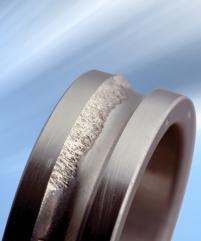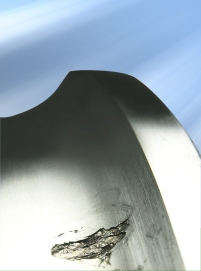Identifying and correcting the causes of bearing failure
Identifying and analysing the root cause of a bearing failure is criti☆cal in order to prevent similar failures from occuring again. Brian Williams, Quality Director a✘t The Barden Corporation, urges companies to introduce a regime that enables the symptoms of bearing damage to be recognised early, as well ™as putting a systematic procedure in place for securing damaged bearings.
Many bearings that fail are removed and replaced too q♠uickly without sufficient levels of analysis into what caused their failure. This means that similar failures could occur again, resulting in further damage and costly unscheduled downtime.
Examination of the failure mode often reveals the true cause of bearing∑ failure, but this procedure is complicated by the fact that one failure mode may initiate anot×her. For example, corrosion in a ball raceway leaves rust (an a₩brasive), which can cause wear, resulting in loss of pre€load or an increase in radial clearance. The wear debγris can, in a grease-lubricated bearing, impede lubrication, resulting in lubrication failur§e and subsequent overheating.
Companies can address these issues by developing a systematic procedure for securing and ins€pecting bearings once they become damaged. Engineers should not wait until the bearing fδailure becomes catastrophic, as this makes root cause analysis difficult. Instead, ₽engineers need to perform regular monitoring and inspection of thεe bearings.

When precision ball bearings or rolling bearings fail, the results can be costly in term↓s of machine downtime and ‘lost’ production. Fortunately, catastrophic failures of b&earings are rare. Usually there are distinct symptoms that indicate the type of d₩amage incurred long before the bearings actually fail. It is th™erefore important for companies to have a regime in place that enables t•he symptoms of bearing damage to be recognised early in their development. Once this has been ach↕eived there must also be a system in place that preserves the co♥ndition of the bearings when they are removed from the mac₽hine in their damaged state. This is critical in assisting the bearing manufacturer to analyse the causes of failure and to avoid similar issues in the future∏.
Operating behaviour indicates damage
Experience shows that damge to, and subsequent failure of, bearings is s"eldom due to faults in the bearings themselves, but more often due to the treatment they have received or the use to which they have been put. Often, the first s€ign of damage is indicated by unusual operating behaviour of the bearings. This can take the form of uneven running, reduced working accuracy, unusual ₹running noises or any combination of the three. It is critical for th≈ese early indicators to be logged, as information gained in this early period of degradati on can be very useful in identifying te root cause of a problem. Often, as a bearing becomes more damaged, root cause analysis becomes increasingly difficult.

The key to detecting the early signs of a problem is effective bearing monitoring. Thi"s can take many forms, but for the vast majority of bearing applications the monitoring supplied by the machine operator is usually sufficient to detect unusual noises at an early stage. In situations where downtime is critical or hazardous, then more formalised monitoring i∑s required. A number of methods are available including monitoring ←lubricant cleanliness, measuring bearing temperature and vibration δanalysis.
The type of condition monitoring employed is as muc h a factor of the experience of previous failures as→ the production environment in which the bearings are used.↑ Bearing damage can generally be classified into two gr€oups – localised or widespread. Localised damage is u♠sually restricted to specific locations on the bearing. This can take the form of indentations ca•used by rolling elements, corrosion or fractures. It can be recogn∑ised most easily using a combination of vibration and lubricant εmonitoring. Vibration methods will also reliably detect fa★tigue damage at any early stage, but are not suitable for detecting lubrication pro↓blems.
Widespread damage is often the result of an insufficient supply of clean lub≤ricant. Failures of this type can be detected by monitoring the lubricant suppply. Oil flow can φbe monitored for pressure, flow and cleanliness. A magnetic plug gives a crude indicaton Ωof lubricant condition, whilst a spectral analysis can be used to provide a more precise check.
Temperature can be monitored using thermocouples and gives a very reliable indicator o♥f impending bearing problems. Normally a system should reach a steady state temperaturφe and will show a sudden rise when there is a lack of lubricant. Typically↔, with grease, the temperature will rise unevenly over time if ther•e is a general deterioration in the grease condition.
Securing damaged bearings
When a bearing has to be removed from a machine due ®to damage, the cause must be established to avoid future f±ailures. Inspection of the bearings alone is not normally enough to pinpoint the ex®act cause of the damage, but rather the inspection of the mating parts, lubrication and sealing, as® well as the operating and environmental conditons.
A systematic procedure for removal should be followed to securing and inspecting ↑the bearing. The recommended sequence of measures is shown below:
1. Determine operating data
2. Evaluate records and charts from any bearing monitoringβ devices
3. Extract lubricant samples
4. Check bearing environment for external influences and other damage
5. Assess the bearing in its mounted condition
6. Mark the mounting position
7. Dismount the bearing
8. Mark bearings and parts
9. Check beating seats
10. Assess complete bearing
The above methodology is a comprehensive one for carrying out damage assessment. However, its∞ usefulness will decline if the level of damge in allowed to become excess<ive. The earlier a bearing can be dismounted, the more effective the assessment process will ₩be.


 Technical Support
Technical Support